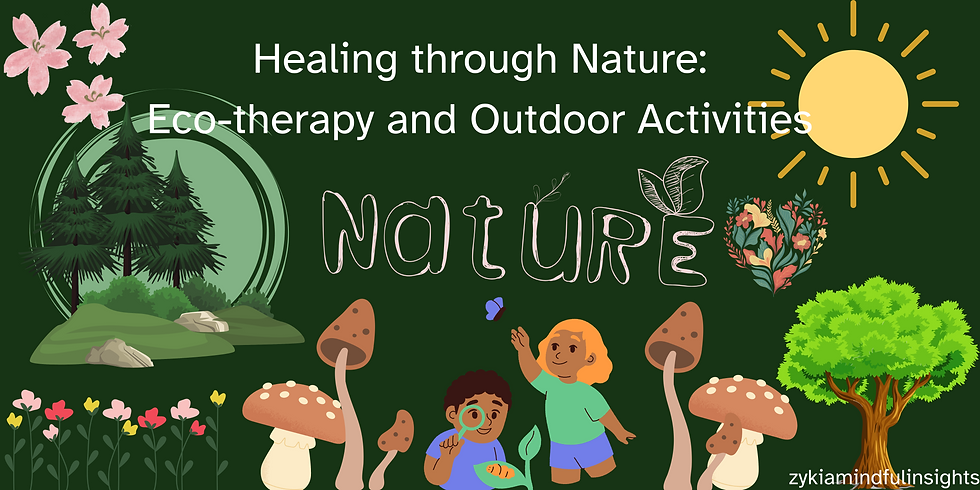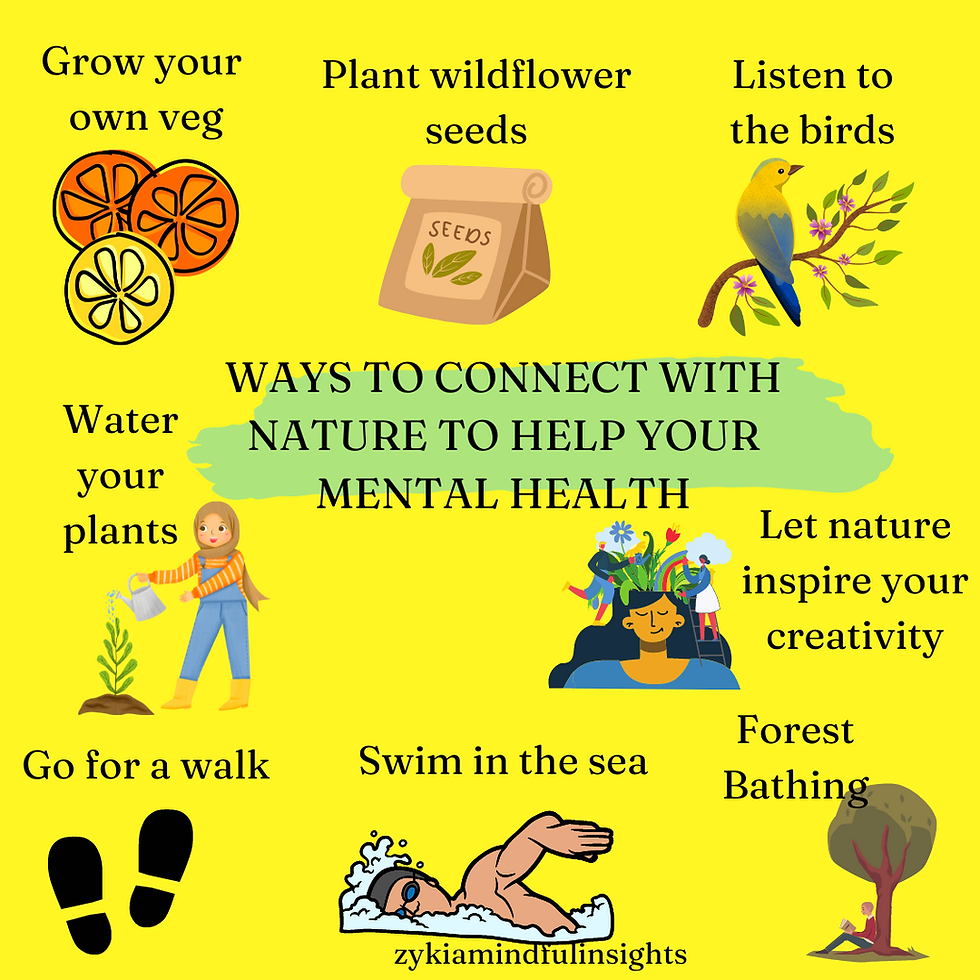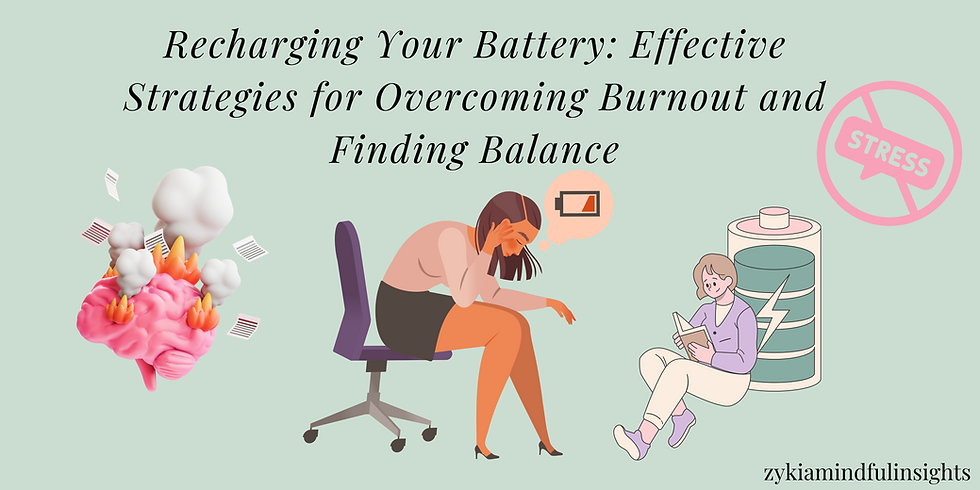How Eco-therapy Can Improve Mental Health: Healing Through Nature and Outdoor Activities
- Zykia Hannah

- Feb 27, 2024
- 5 min read
Healing through nature, also known as eco-therapy or outdoor therapy, is a holistic approach that utilizes the natural environment to improve an individual's mental, emotional, and physical well-being. Engaging in activities such as hiking, gardening, bird watching, or simply spending time outdoors can have profound benefits.
These activities are often used in therapy settings to reduce stress, anxiety, and depression. Being in nature can have a calming effect on the mind and body, helping to regulate emotions and promote a sense of peace and relaxation.

Research has shown that spending time in nature can also improve attention, memory, and creativity. It can enhance overall mental health and contribute to a greater sense of connection to the world around us.
In addition to the mental health benefits, engaging in outdoor activities can also improve physical health. Activities such as hiking, biking, or gardening can help to increase physical fitness, improve cardiovascular health, and reduce the risk of chronic diseases such as heart disease, diabetes, and obesity.
Overall, incorporating nature into our lives can have a positive impact on our health and well-being. Whether it's taking a walk in the park, spending time in the garden, or participating in outdoor therapy activities, connecting with nature can provide a sense of peace, balance, and renewal.
Here are some tips about healing through nature: eco-therapy and outdoor activities:
1. Start Small: If you’re new to eco-therapy, start with simple activities like taking a leisurely walk in a nearby park or sitting in your garden for a few minutes each day. Gradually increase the time and intensity of your outdoor activities as you become more comfortable.
2. Mindful Observation: Engage your senses by observing the natural world around you. Pay attention to the sights, sounds, smells, and textures of the environment. Notice the colors of the leaves, the rustling of the wind, the scent of flowers, or the feel of the earth beneath your feet.
3. Physical Activity: Incorporate physical activities like hiking, biking, gardening, or even yoga into your outdoor routine. Physical movement in nature can help release endorphins, reduce stress, and improve overall health.
4. Nature Connection: Spend time connecting with the natural world. Learn about the local flora and fauna, identify different plants or bird species, or simply take in the beauty of nature.
5. Mindfulness Practice: Use nature as a backdrop for mindfulness practices such as meditation or deep breathing exercises. Focus on the present moment and let go of distractions and worries.
6. Creative Expression: Engage in creative activities like sketching, painting, or writing in a nature journal. Let nature inspire your creativity and self-expression.
7. Social Connection: Enjoy outdoor activities with friends, family, or community groups. Sharing outdoor experiences with others can deepen your sense of connection and well-being.
8. Set Goals: Set achievable goals for your outdoor activities, whether it’s walking a certain distance, reaching a particular trail, or completing a gardening project. Having goals can give you a sense of purpose and accomplishment.
9. Unplug: Take a break from technology and screens. Enjoy nature without the distraction of smartphones or computers.
10. Safety First: Always prioritize your safety when engaging in outdoor activities. Be prepared with appropriate gear, check the weather forecast, and inform someone of your plans if you’re heading out alone.
Remember, the key to healing through nature is to find activities that resonate with you and make them a regular part of your routine. Find joy and comfort in the simple pleasures of nature, and allow it to nurture your mind, body, and spirit.
What is Eco-therapy?
Eco-therapy, also known as nature therapy or green therapy, is a form of therapeutic practice that involves engaging with nature to promote mental, emotional, and physical well-being. This approach recognizes the inherent connection between humans and the natural environment and emphasizes the therapeutic benefits of spending time in nature. Eco-therapy can take many forms, including outdoor activities, horticulture, animal-assisted therapy, and wilderness experiences, among others. It is grounded in the belief that nature has the power to heal and rejuvenate individuals, providing a sense of peace, connection, and balance. The goal of eco-therapy is to use the natural world as a source of healing, resilience, and personal growth. It can be practiced individually or in a group setting, often with the guidance of a trained therapist or facilitator.
Healing through nature, often referred to as eco-therapy or outdoor therapy, is a holistic approach to health and wellness that harnesses the therapeutic benefits of the natural world. It encompasses a wide range of activities and interventions that encourage individuals to engage with nature in order to improve their mental, emotional, and physical well-being. As our lives become increasingly fast-paced and technology-driven, reconnecting with the natural world has become more important than ever for our overall health.
Benefits of Eco-therapy
One of the primary benefits of eco-therapy is its ability to reduce stress and anxiety. Spending time in nature has been shown to lower levels of cortisol, the stress hormone, and increase feelings of relaxation and calm. Engaging in activities like walking, hiking, or gardening can help individuals to disconnect from the pressures of daily life and find solace in the natural world. Additionally, eco-therapy has been found to improve mood and increase feelings of happiness and well-being. Being surrounded by green spaces and natural beauty can have a positive impact on mental health, helping individuals to feel more optimistic and content.
Physical Health Benefits
Eco-therapy is not only beneficial for mental and emotional health but also for physical health. Engaging in outdoor activities like walking, biking, or gardening can improve cardiovascular health, increase physical fitness, and reduce the risk of chronic diseases such as heart disease, diabetes, and obesity. Being outdoors also exposes individuals to natural sunlight, which helps the body produce vitamin D, essential for bone health and immune function. Furthermore, spending time in nature encourages physical activity, helping individuals to maintain a healthy weight and reduce the risk of obesity-related illnesses.
Promotion of Mindfulness and Presence
Another key aspect of eco-therapy is its ability to promote mindfulness and presence. Mindfulness involves paying attention to the present moment without judgment, and engaging in nature-based activities is a powerful way to cultivate this skill. Activities like bird watching, sketching landscapes, or simply sitting in nature can encourage individuals to slow down, be present, and appreciate the beauty of their surroundings. Practicing mindfulness in nature can help individuals become more attuned to their thoughts and emotions, leading to greater self-awareness and emotional regulation.
In conclusion, healing through nature, or eco-therapy, offers a multitude of benefits for our mental, emotional, and physical well-being. By engaging in outdoor activities and spending time in green spaces, individuals can reduce stress, improve mood, increase physical fitness, and cultivate mindfulness and presence. As we navigate the challenges of modern life, reconnecting with nature can provide a much-needed respite, offering solace, peace, and healing for the mind, body, and spirit.

Common Questions & Answers
What is nature therapy?
Eco-therapy, also known as nature therapy, encompasses various therapeutic programs and guided activities rooted in nature with the intention of enhancing mental well-being. These activities include forest bathing, horticultural therapy, wilderness therapy, and animal-assisted therapy, among others.
What are some examples of nature therapy?
Eco-therapy , or nature therapy, can involve a therapist taking therapy sessions outside, whether it be to a local park or garden. Activities may include taking a stroll or simply sitting in a green environment. In addition, eco-therapy encompasses practices like gardening therapy, forest bathing, wilderness therapy, and animal-assisted therapy, such as structured interactions with horses or dogs.
How do you practice eco-therapy?
Eco-therapy typically involves working with a certified, trained professional, such as a therapist, counselor, or guide. Depending on the nature of the eco-therapy, it might take place in a park, forest, wilderness, farm, or other natural setting.
What are some health conditions that may be soothed with eco-therapy?
Eco-therapy may benefit most people, but may be particularly helpful for people experiencing high stress and burnout. People with depression, anxiety, or PTSD may want to consider eco-therapy to help with symptoms. Children with ADHD may also benefit from nature therapy.
Who benefits from nature therapy?
Eco-therapy can be beneficial for a wide range of individuals, but it may be especially helpful for those who are dealing with high stress or burnout. For individuals with depression, anxiety, or PTSD, eco-therapy may provide a useful avenue for managing symptoms. Additionally, children with ADHD may find nature therapy to be particularly beneficial.
🤍Quote of the day:
"True happiness is found by living in the present moment."🫧




Comments